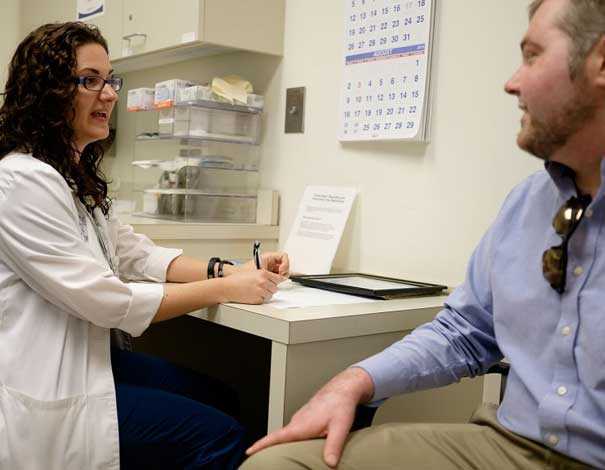Tom, transplant recipient
Medical marijuana, also known as medical cannabis, has been a hot topic in the news recently with claims that it can treat certain symptoms or even cure some illnesses. Here, we’ll talk about medical marijuana after BMT, including risks, potential uses, and questions to ask your doctor.
If you look online and talk with transplant recipients, you’ll certainly hear stories about medical marijuana reducing symptoms for people. While it may be tempting to jump on the bandwagon, Chris Rimkus, an advanced practice registered nurse (APRN) and BMT manager at SSM Health Saint Louis University Hospital, recommends being careful. These anecdotes are moving, but they’re not science.
Real risks, possible benefits
Chris has studied the research on medical marijuana for people who’ve had a BMT. She learned that there are mixed results and limited information. “Unfortunately, we still don’t know a lot about the risks and benefits,” she says.
“Medical marijuana has been studied for reducing nausea and anxiety and increasing appetite,” Chris adds. But researchers couldn’t show that symptoms got better compared to other treatments. The studies did, however, find serious risks, such as infections. “It can even cause inflammation,” she cautions, “which could trigger graft-versus-host disease (GVHD).”
“The risk of infection is high, especially for people getting cancer treatment,” Chris notes. “For BMT recipients specifically, there is the risk of inflammation in the lungs and intestines.”1,2 Other possible side effects include changes in mood, heart rate and blood pressure. Marijuana can also affect your thinking, causing symptoms like “chemo brain” or even psychosis.3
Keep in mind
- Different forms of marijuana have different risks. Marijuana can be smoked, put into teas, taken as pills, and used as creams or sprays. The doses and risks are different depending on how it’s taken. For example, people who smoke marijuana have a higher risk of lung infections.
- Laws vary in each state. More than 33 states plus Washington D.C. have laws that allow the use of medical marijuana to some degree. But the details are different for each state, including where you can buy it and when doctors can prescribe it. Learn about laws in your state.
- Consider the cost. Because medical marijuana after a BMT is not approved by the U.S. Food and Drug Administration (FDA), it’s unlikely that your health insurance will pay for it. Using it could also affect the status of your health insurance.
- Your doctor may not know all the risks. If you’re going to your primary care or cancer doctor for a medical marijuana prescription, talk to your transplant doctor first. Chris notes, “Your other doctors may prescribe marijuana, but they may not know the risks specific to BMT.”
- Stay tuned for more research. Medical marijuana may help some people, but there is limited research on using it after BMT. Doctors in Israel studied cannabidiol (CBD), an ingredient in marijuana, to prevent GVHD.4 Only 48 people were in their study, but the doctors are hopeful that taken with standard treatments it could help prevent GVHD. To date, there are no studies in the U.S. enrolling people to take medical marijuana after transplant.
Until there’s more research, Chris remains cautious. When you see ads for medical marijuana, Chris says to keep in mind that “marijuana is a business so there is a push to increase sales.” Look for information from trusted organizations, like the FDA or the American Society of Transplantation and Cellular Therapy.
Questions to ask your transplant doctor
- What is your experience with prescribing medical marijuana for people after BMT?
- What are possible risks and benefits for me?
- Is there anything else that I can do or take to help ease my symptoms?
If your BMT doctor doesn’t recommend medical marijuana, but you plan to take it, let your doctor know. They need accurate information about all the drugs you’re taking so they can best care for you. Be sure to say:
- I still plan to try it. How long should I wait after my transplant before I use it?
Resources for you
- Read the FDA consumer update: What you need to know about cannabis.
-
Get help finding clinical trials:
- Call: 1 (888) 814-8614
- Email: clinicaltrials@JCCTP.org
-
Contact the Patient Support Center for information and support:
- Call or Text: 1 (888) 999-6743
- Email: patientinfo@nmdp.org
References
- Gargani, Y., Bishop, P., & Denning, D. W. (2011). Too many mouldy joints - marijuana and chronic pulmonary aspergillosis. Mediterranean Journal of Hematology and Infectious Diseases, 3(1), e2011005. doi: 10.4084/MJHID.2011.005.
- Ruchlemer, R., Amit-Kohn, M., Raveh, D., Hanus, L. (2015). Inhaled medicinal cannabis and the immunocompromised patient. Supportive Cancer Care, 22(3), 819-822. doi: 10.1007/s00520-014-2429-3
- Di Forti, M., Quattrone, D., Freeman, T.P. et al. (2019). The contribution of cannabis use to variation in the incidence of psychotic disorder across Europe: a multicentre case-control study. Lancet Psychiatry, 6(5), 427-436. doi: 10.1016/S2215-0366(19)30048-3.
- Yeshurun, M., Shpilberg, O., Shargian, L. et al. (2015). Cannabidiol for the Prevention of Graft-versus-Host-Disease after Allogeneic Hematopoietic Cell Transplantation: Results of a Phase II Study. Biology of Blood and Marrow Transplantation, 21(10), 1770-1775.

